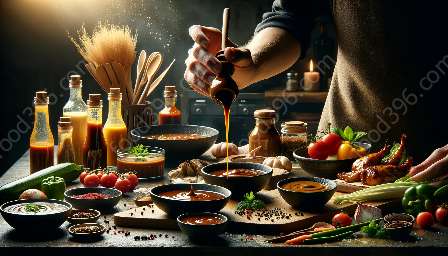Velouté sauce is a classic French sauce that plays a significant role in the art of sauce making and food preparation techniques. In this comprehensive guide, we will explore the origins, ingredients, preparation, and variations of velouté sauce, as well as its compatibility with other culinary practices.
Origins of Velouté Sauce
Velouté sauce, which translates to 'velvety' in English, is one of the five mother sauces in classical French cuisine. It was first documented in the 17th century and has since become a staple in kitchens worldwide. The sauce is derived from a roux, a mixture of equal parts flour and fat, and a light stock, such as chicken, fish, or veal stock.
Ingredients and Preparation
The key ingredients for velouté sauce are:
- Butter or other fat
- Flour
- Light stock (chicken, fish, or veal)
The preparation of velouté sauce begins with creating a roux by melting the fat in a saucepan and whisking in the flour until smooth. This mixture is then slowly combined with the light stock and simmered until it reaches a smooth, velvety consistency. The result is a light, elegant sauce with a delicate flavor that serves as a versatile base for a variety of dishes.
Variations and Applications
Velouté sauce can be tailored to suit a wide range of dishes by adjusting the type of stock used and incorporating additional seasonings and flavorings. Some popular variations include:
- Suprême sauce, made with chicken velouté and cream
- Allemande sauce, enriched with egg yolks and lemon juice
- Normande sauce, which includes white wine, fish stock, and mushrooms
Velouté sauce serves as an essential component in many classic dishes, such as chicken pot pie, seafood gratins, and creamy soups. Its smooth texture and delicate taste add depth and richness to various culinary creations.
Compatibility with Sauce Making
Understanding velouté sauce is integral to mastering the art of sauce making. Its preparation involves fundamental techniques, including roux-making, stock preparation, and emulsification. As a base sauce, velouté serves as a building block for creating secondary sauces by incorporating additional ingredients or reductions, demonstrating its versatility and compatibility within the realm of sauce making.
Integration with Food Preparation Techniques
In the realm of food preparation techniques, velouté sauce plays a crucial role in enhancing dishes and creating harmonious flavor profiles. Whether used as a standalone sauce, a binding agent, or a flavor enhancer, velouté sauce pairs seamlessly with various cooking methods, such as braising, poaching, and pan-searing, elevating the overall sensory experience of a dish.
Conclusion
Velouté sauce embodies the elegance and versatility that characterize French culinary traditions. Its compatibility with sauce making and food preparation techniques underscores its importance in the culinary world. Aspiring chefs and enthusiasts alike can elevate their culinary prowess by mastering the art of velouté sauce and appreciating its multifaceted applications in creating exquisite dishes.

